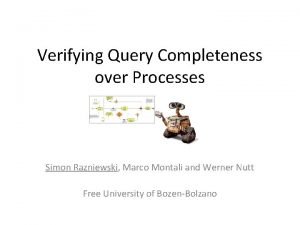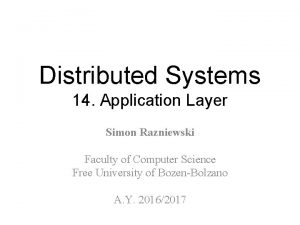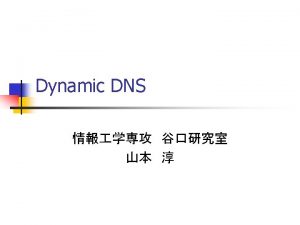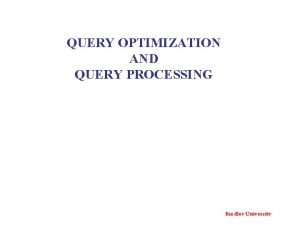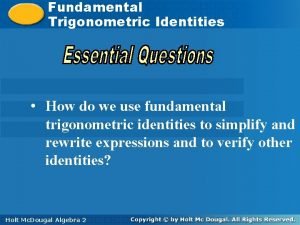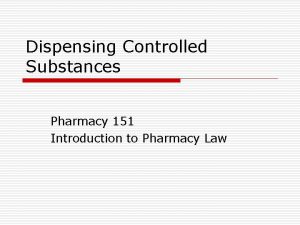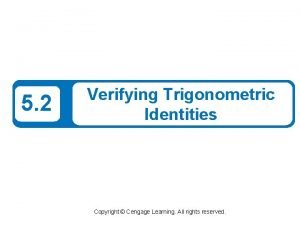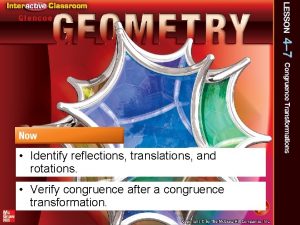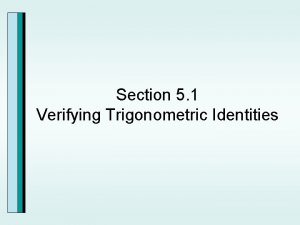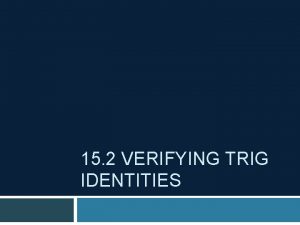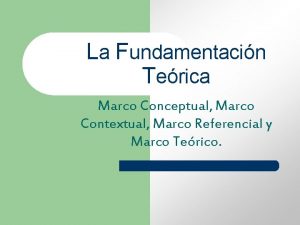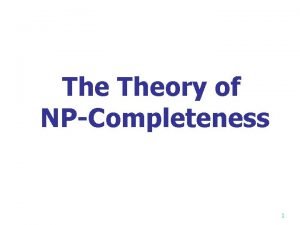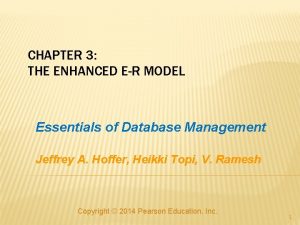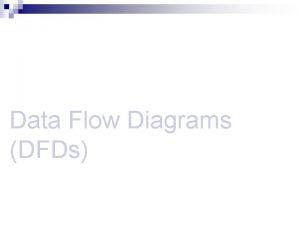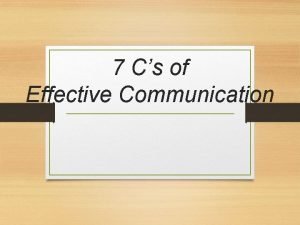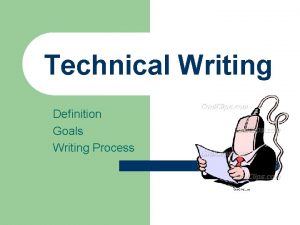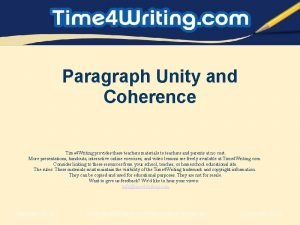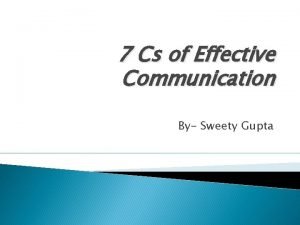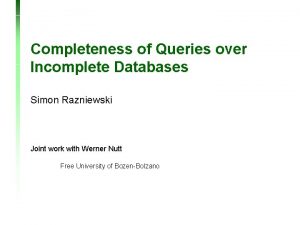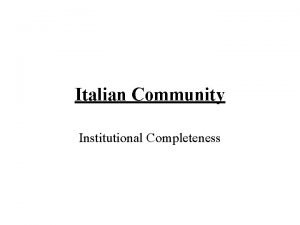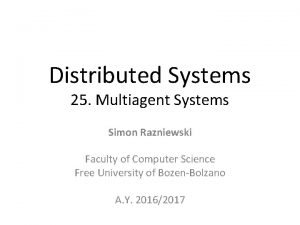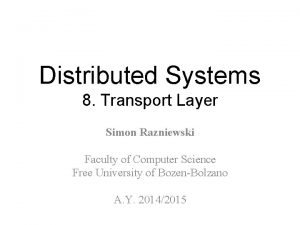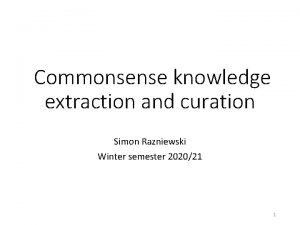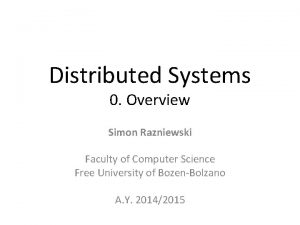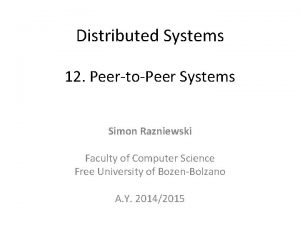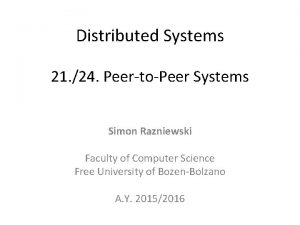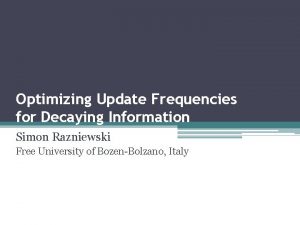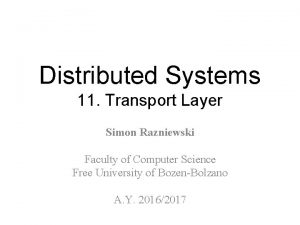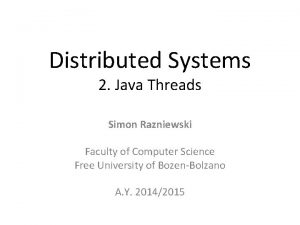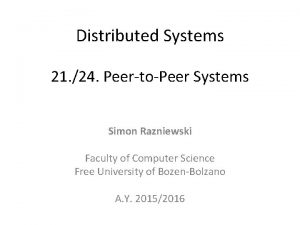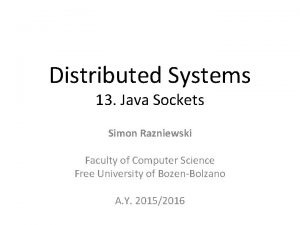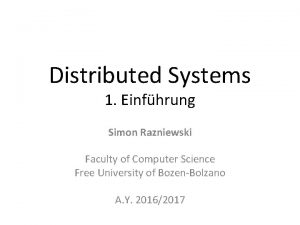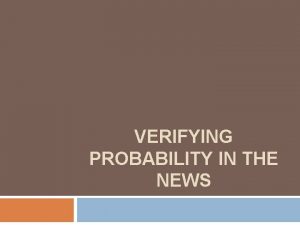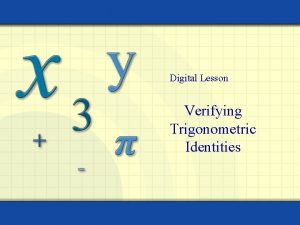Verifying Query Completeness over Processes Simon Razniewski Marco

























- Slides: 25

Verifying Query Completeness over Processes Simon Razniewski, Marco Montali and Werner Nutt Free University of Bozen-Bolzano

Observation • Often, process execution is only partially formal (pen&paper, email, phone, …) Valid information may be stored in databases with delays Database content is of questionable completeness 2

Background: School Management in the Province of Bolzano • Province has central database about pupils, teachers, etc. • Would like to answer statistical queries • Problem: Data often entered with delays • Thus, administrators would like to know whether a query is currently reliable (complete) 3

Enrolment Process in a School Database query: How many pupils? 0 Is that correct? Database query: How many pupils? 137 Is that correct? 4

Observation • At some points, new facts in the real world have not yet been stored queries may give wrong answers • At other points, all facts that hold in the real world have been stored queries give correct answers 5

Formalization: Two Databases Conceptually, there are - the state of the information system - the state of the real world We model - each state as a database - the process interacting with both Process Real world Interaction School database 6

Two databases: Example Process Real world Interaction School database • Deciding about enrolments: – read from and write into real-world database • Recording accepted enrolments into the information system: – read from real-world database – write into information system database 7

Completeness Problem Process Real world Interaction Information system Query: How many pupils are enrolled? Does the information system contain all the enrolments? 8

Research Questions • How can we express which data a process generates? • How can we express which data are recorded in the information system? • How are reads and writes of data related? • What does completeness mean? • How can we find out whether a query is complete? 9

Model: Quality-aware Transition Systems • Goal: General technique applicable to different modeling languages • Therefore, we use transition systems as mathematical formalism – Petri nets can be encoded using their reachability graph (possibly exponential encoding due to parallelism) • Actions in our transition systems can be labeled with two kinds of effects: – Real-world effects: allow to create new data in the real world – Copy effects: store information that holds in the real world into the information system Thus, our models are data-monotonic 10

Example Revisited Copy effect: Copies the new enrolments into the school database Real-world effect: Generates enrolments 11

Real-world and Copy Effects • Real-world effects are nondeterministic, copy effects are deterministic 12

Completeness Verification Given – Process description – State S – Query Q Question Is it safe to pose the query Q in state S against the information system database? 13

Completeness Verification (2) A state S of a QATS satisfies completeness for a query Q, if for all paths leading to S, for all process-compliant database developments ((Drw 0, Dis 0), . . , (Drwn, Disn)), Q(Dnis) = Q(Dnrw) Meaning: In state S the information system gives the same result as holds in the real world This is what we want to decide! 14

Compliance When does a development ((Drw 0, Dis 0), . . , (Drwn, Disn)) comply to a sequence of real-world and copy effects? 15

Compliance to Real-world Effects • request(John, HS) request(Mary, HS) pupil(John, HS) request(Mary, HS) Pupil(Mary, HS) request(John, HS) request(Mary, HS) pupil(John, HS) Pupil(Mary, HS) 16

Compliance to Copy Effects Real-world database pupil(John, HS) Pupil(Mary, HS) Copy effect: pupilrw(n, HS) → pupilis(n, HS) Resulting information system database …. pupil(John, HS) Pupil(Mary, HS) …. Because “ ” is deterministic 17

Results – Completeness over Paths • A real-world effect is risky wrt. a query, if it has the potential to change the query result Adding pupils in class 1 A is risky wrt. a query for all pupils, but not wrt. a query for all pupils in level 2 • Copy effects can repair a risky effect, if they copy all data that has the potential to change the query result Copying all pupils in level 1 into the information system repairs the risky effect. • Result: A query is complete over all developments of a path, if all risky actions in the path are repaired Theorem: Repair checking can be reduced to query containment – Query containment for conjunctive queries (SELECT … FROM … WHERE …) has been well studied in database research 18

Results – Completeness in States • Completeness holds in a state, if it holds for all paths that lead to that state • A priori, infinitely many paths (due to cycles) Theorem: Repeated actions can be ignored – Thus, only finitely many paths to consider – Still, number of paths can be exponential wrt. the QATS 19

Completeness Checking - Intuition Middle School A High School B How many high school pupils? How many middle school pupils? s 3 Decide enrolments Record enrolments s 1 Record enrolments s 6 Record enrolments Decide enrolments s 4 s 0 Record enrolments s 8 Decide enrolments s 2 Decide enrolments Record enrolments s 7 s 5 20

Complexity Query and effect language Complexity of completeness checking for a path Complexity of completeness checking for a state Arbitrary conjunctive queries (CQ) ΠP 2 -complete CQs without <, ≤ NP-complete In ΠP 2 CQs without selfjoins co. NP-complete CQs without selfjoins and without <, ≤ PTIME in co. NP 21

Applications • Annotation of statistics and KPI with completeness information (see next slide) • Process mining (trace analysis) - to validate whether queries over traces return the real state of the process • Auditing – to verify whether the information about the realworld is properly stored 22

Possible Use: Statistical Reports School Report 2013 Pupils in primary schools: 548 Pupils in middle schools: 390 Pupils in high schools: 242 Pupils taking English: 1157 Pupils taking French: 685 Pupils taking Chinese: 52 ……. Data from the Da Vinci School and the Gherdena School is missing The Hofer School did not enter its language course attendance yet 23

Conclusion • Introduced the problem of query completeness due to delays between real-world events and their recording in a database • Modelling of the problem using quality-aware transition systems that interact both with the real world and with an information system • Showed how to verify query completeness over such models • Future work: Demo for a high-level process language (BPMN or YAWL) 24

Thank you! Questions? 25
 Marco montali
Marco montali Simon razniewski
Simon razniewski Query tree and query graph
Query tree and query graph Iterative vs recursive dns
Iterative vs recursive dns Query tree and query graph
Query tree and query graph Fundamental trigonometric identities
Fundamental trigonometric identities Dea number
Dea number Geeky medics certifying death
Geeky medics certifying death Cot2x identity
Cot2x identity Verify trigonometric identities
Verify trigonometric identities How can you verify congruency
How can you verify congruency Verifying trig identities
Verifying trig identities Verifying trig functions
Verifying trig functions Verifying trigonometric identities calculator
Verifying trigonometric identities calculator Concurrent processes are processes that
Concurrent processes are processes that Cuadro comparativo entre marco teorico y marco conceptual
Cuadro comparativo entre marco teorico y marco conceptual Over the mountains over the plains
Over the mountains over the plains Siach reciting the word over and over
Siach reciting the word over and over Taking over navigational watch
Taking over navigational watch Np complete
Np complete Completeness constraint example
Completeness constraint example Logical dfd and physical dfd
Logical dfd and physical dfd Completeness communication
Completeness communication Goal for technical writing
Goal for technical writing Unity of a paragraph
Unity of a paragraph It should convey all facts required by the audience
It should convey all facts required by the audience
